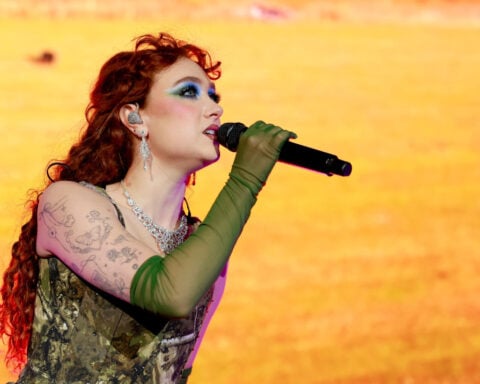The Oscars are no longer just a celebration of movies. They’ve also become a fashion show, with fans, designers and the media celebrating and critiquing Hollywood celebrities as they stroll, pause and pose on the red carpet of the annual awards ceremony.
A sharp look can be a story in and of itself.
Take actress Lupita Nyong’o. After she wore a powder blue Prada dress to the 2014 Oscars, she became the new “It girl” overnight. She was named People magazine’s Most Beautiful Woman, became the first Black ambassador for beauty giant Lancôme and landed on the covers of Vogue, Vanity Fair and Glamour.
But fashion wasn’t always so central to the ceremony.
In my book about the history of the Oscars red carpet, I point to two essential figures that turned the Oscars into the fashion spectacle we know today.
TV puts the Oscars in the spotlight
At the end of the 1940s, the Hollywood film industry was facing economic headwinds.
More and more households were buying television sets, which impacted movie-going. The studios also saw their revenues decline when they were forced to sell their theater chains after losing an antitrust case in 1948.
Financial struggles continued to mount when, in 1949, the motion picture companies refused to fund the Academy Awards after the Academy of Motion Picture Arts and Sciences, the organization that puts on the awards, allowed British films to compete head-to-head with American productions.
The organization found temporary solutions to keep the event going. But when faced with the possibility of discontinuing the Oscars ceremony altogether due to financial constraints, the academy weighed the advantages and disadvantages of airing the program on television, which was seen as film’s main competitor. Eventually, the academy approached NBC and requested that the network cover the expenses to put on the event in exchange for the rights to broadcast the show in 1953.
Until then, the studios had carefully crafted and controlled their stars’ public image. Television was a new medium – and a more spontaneous one. Studio executives feared how their stars would appear on screen and behave during the broadcast. Furthermore, many nominees were skeptical of appearing at the event since there was no stipulation in their contracts about television appearances.
Edith Head, guardian of glamour
So the academy hired Edith Head as a fashion consultant to supervise the stars’ appearance.
At the time, Head was Hollywood’s most famous costume designer. She’d been working since the days of silent cinema, and she was accustomed to the media spotlight through her promotional work for Paramount.
Head was responsible for making sure that everyone dressed appropriately, abiding by the “decency and decorum” guidelines suggested by the Code of Practice for Television Broadcasters. She also had to ensure that no two dresses were the same and that the outfits worn by presenters and nominees looked good on camera and complemented the set.

One of her most important roles ended up being talking up fashion in media interviews leading up to the Oscars, which she frequently referred to as a fashion show.
“This is a very competitive night from a fashion point of view because, as I said, the stars are presenting themselves as themselves,” Head explained on one of her radio shows. “For me, as a fashion designer, the most exciting question is who will wear what.”
The postwar growth of the international fashion industry paved the way for Hollywood stars to wear the latest creations by European designers, including Christian Dior, Hubert de Givenchy and Pierre Balmain.
However, by the mid-1960s, new fashion trends such as miniskirts, shapeless dresses, pants and bohemian styles threatened to upend the formal attire of the Oscars and the feminine ideals preferred by Head.
In 1968, she felt compelled to remind young actresses of the event’s stature with a press release after actress Inger Stevens wore a mini dress to the ceremony in 1967. To Head, this was no informal social gathering; it was a glamorous, upscale fashion parade.
Two years later, in 1970, she reiterated the importance of formal attire while announcing the nominees for the Oscar for best costume design. She reminded young actresses that the Oscars was “the most important time of the year in Hollywood” and advised them to avoid wearing “the freaky, far-out, unusual fashions.”
Fred Hayman rights the ship
After Head said goodbye to her position at the conclusion of the 1971 ceremony, celebrities blew through the boundaries of decorum, inaugurating an era of questionable fashion choices: Edy Williams’ shocking bikini looks, Bob Mackie’s memorable transparencies for Cher and Armani’s over-the-top informality for Diane Keaton.

Fashion order was restored in 1989 when Beverly Hills impresario Fred Hayman became the event’s new fashion coordinator.
Lucky for him, in the 1990s, fashion was in fashion.
New successful designers such as Giorgio Armani, Thierry Mugler and Gianni Versace elbowed into the spotlight alongside established conglomerate brands like Louis Vuitton and Givenchy. Supermodels had become celebrities on par with actors and actresses, and cable television launched specialized international networks dedicated entirely to fashion and celebrity culture.
Hayman was eager to capitalize on this momentum to promote Rodeo Drive as the luxury shopping mecca of the West Coast.
Hayman had begun his career in the hospitality industry. But in 1961, he switched to fashion after investing in a friend’s boutique, Giorgio Beverly Hills. Hayman would eventually become the boutique’s sole owner. In 1989, the same year he joined the Oscars as fashion coordinator, he rebranded his store as Fred Hayman Beverly Hills after selling the Giorgio brand to cosmetics conglomerate Avon to commercialize his perfume line.
Giorgio Beverly Hills catered to the rich and famous by retailing garments from various designers and brands from Europe and New York City. As fashion coordinator of the Oscars, Hayman became the official go-to resource for what to wear to the event, attracting more celebrities, brands and media attention to Rodeo Drive.
Building off Head’s media strategy, Hayman introduced the fashion previews. These were runway shows for the press organized at the Samuel Goldwyn Theatre on Wilshire Boulevard to anticipate each year’s red-carpet trends.

Fashion at the Oscars took a giant leap forward with Hayman. Thanks to his efforts, the West Coast enhanced its fashion profile, prompting luxury brands to open flagship stores along Rodeo Drive.
He continued in his role for a decade until he was replaced by stylist L’Wren Scott for the ceremony in 2000.
Through their media savvy, Head and Hayman were able to recast the Academy Awards ceremony as a dazzling spectacle of glamour – what Head frequently described as “the biggest international fashion show free-for-all.”

Elizabeth Castaldo Lundén does not work for, consult, own shares in or receive funding from any company or organization that would benefit from this article, and has disclosed no relevant affiliations beyond their academic appointment.
Source: The Conversation

 Trump endorses Mike Johnson to stay on as House Speaker after government funding turmoil
Trump endorses Mike Johnson to stay on as House Speaker after government funding turmoil
 Six former Florida State players suing coach Leonard Hamilton over failed NIL payments
Six former Florida State players suing coach Leonard Hamilton over failed NIL payments
 Cheniere produces first LNG at Corpus Christi Stage 3 project
Cheniere produces first LNG at Corpus Christi Stage 3 project
 The world population will be 8.09 billion on New Year's Day after a 71 million increase in 2024
The world population will be 8.09 billion on New Year's Day after a 71 million increase in 2024
 Biden announces nearly $2.5B more in military aid for Ukraine
Biden announces nearly $2.5B more in military aid for Ukraine
 US announces $5.9 billion in military and budget aid to Ukraine
US announces $5.9 billion in military and budget aid to Ukraine
 Kristin Cavallari offers up NSFW details about her romance with Morgan Wallen
Kristin Cavallari offers up NSFW details about her romance with Morgan Wallen
 What investigators are looking for at the South Korea airplane crash site
What investigators are looking for at the South Korea airplane crash site
 The dress actress Lupita Nyong'o wore to the 86th Academy Awards in 2014 became a story in and of itself.
The dress actress Lupita Nyong'o wore to the 86th Academy Awards in 2014 became a story in and of itself.







